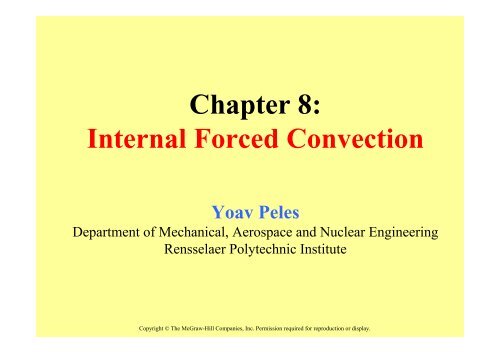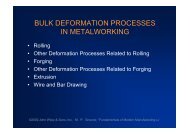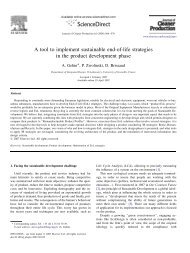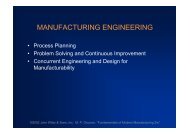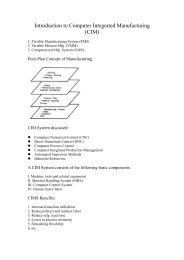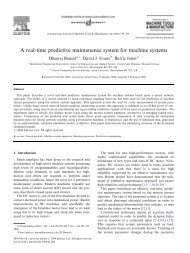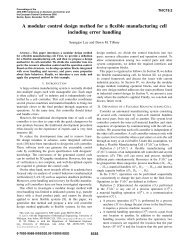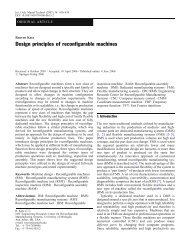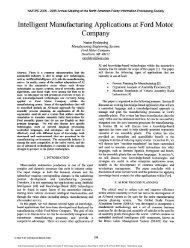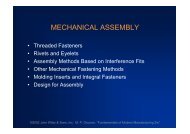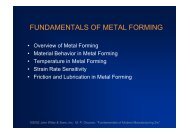Chapter 8: Internal Forced Convection
Chapter 8: Internal Forced Convection
Chapter 8: Internal Forced Convection
- No tags were found...
You also want an ePaper? Increase the reach of your titles
YUMPU automatically turns print PDFs into web optimized ePapers that Google loves.
<strong>Chapter</strong> 8:<strong>Internal</strong> <strong>Forced</strong> <strong>Convection</strong>Yoav PelesDepartment of Mechanical, Aerospace and Nuclear EngineeringRensselaer Polytechnic InstituteCopyright © The McGraw-Hill Companies, Inc. Permission required for reproduction or display.
Introduction• Pipe circular cross section.• Duct noncircular cross section.• Tubes small-diameter pipes.• The fluid velocity changes from zero at the surface(no-slip) to a maximum at the pipe center.• It is convenient to work with anaverage velocity, which remainsconstant in incompressible flowwhen the cross-sectional areais constant.
Average Velocity• The value of the average velocity is determined fromthe conservation of mass principle (8-1)m ρV A ρu r dA= =∫( )avg C CA• For incompressible flow in a circular pipe of radius RVavgρu r dA∫ ( )RC= ρu( r)πrdrAc= ∫0=Cc2 2ρA ρπR R2 2R∫0u r rdr( )(8-2)
Average Temperature• It is convenient to define the value of the meantemperature T m from the conservation ofenergy principle.• The energy transported by the fluid through across section in actual flow must be equal tothe energy that would be transported throughthe same cross section if the fluid were at aconstant temperature T mE = mcT = ∫cT( r) δm = ∫ ρcT( r) u( rVdA ) (8-3)fluid p m p p cmAc
• For incompressible flow in a circular pipe of radius RTm∫cT rcT r ρu r 2πrdr( ) δ m( ) ( )ppm= =Ac2R(2π )mc ρV R cp avg p=∫ (8-4)Vavg( ) ( )• The mean temperature T m of a fluid changes duringheating or cooling.2R∫0T r u r rdrIdealizedActual
Laminar and Turbulent Flow in Tubes• For flow in a circular tube, the Reynolds number isdefined asρVavgD VavgDRe = = (8-5)µ ν• For flow through noncircular tubes D is replaced bythe hydraulic diameter D h .Dh4Ac= (8-6)P• laminar flow: Re10,000.
The Entrance Region• A fluid entering a circular pipe at a uniform velocity.• The no-slip condition - the flow in a pipe is divided intotwo regions:– (i) boundary layer region, (ii) irrotational (core) flow region• The thickness of this boundary layer increases in theflow direction until it reaches the pipe center.IrrotationalflowBoundarylayer
• Hydrodynamic entrance region the region from thepipe inlet to the point at which the boundary layer mergesat the centerline.• Hydrodynamically fully developed region the regionbeyond the entrance region in which the velocity profile isfully developed and remains unchanged.• The velocity profile in the fully developed region is– parabolic in laminar flow, and– somewhat flatter or fuller in turbulent flow.
Thermal Entrance Region• Consider a fluid at a uniform temperature entering a circular tubewhose surface is maintained at a different temperature.• Thermal boundary layer along the tube is developing.• The thickness of this boundary layer increases in the flowdirection until the boundary layer reaches the tube center.• Thermal entrance region.• Thermally fully developed region the region beyond thethermal entrance region in which the dimensionless temperatureprofile expressed as(T s -T)/(T s -T m )remains unchanged.
– Hydrodynamically fully-developed:∂u r,x( )∂x= 0 → u =u r( )(8-7)– Thermally fully-developed:∂ ⎡Tsx −T r,x⎢∂x⎢⎣Tsx −Tmx( ) ( )( ) ( )⎤⎥⎥⎦=0(8-8)∂⎛Ts−T⎞ − ∂T∂r⎜⎟∂ r ⎝T − T ⎠T −T( )r =R= ≠s m r =Rs mfx( )(8-9) 數 數
• Surface heat flux can be expressed as∂Tk( ∂T ∂r)( )r=Rqs = hx Ts − Tm = k → hx=∂r r=RTs−Th m• For thermally fully developed region From (Eq. (8-9))(8-10)∂T( )Ts∂r−Tmr=R≠fx( )h ≠ f xx( )Fully developed flowhx=constantFully developed flow
Heat Transfer coefficient and Friction factorDevelopingregionFullydevelopedregionL h L t ?
Entry Lengths ()– HydrodynamicLaminar flowL≈ ⋅ D (8-11)h,laminar0.05Re– ThermalL ≈ 0.05Re⋅Pr⋅ D= Pr⋅ L (8-12)t,laminarh,laminar– HydrodynamicTurbulent flowL14= D⋅ (8-13),1.359 Reh turbulent– Thermal(approximate)L ≈ L ≈ D (8-14)h, turbulent t, turbulent10
Turbulent flow Nusselt Number• The Nusselt numbers are muchhigher in the entrance region.• The Nusselt number reachesa constant value at a distanceof less than 10 diameters.• The Nusselt numbers for theuniform surface temperature and uniform surface heatflux conditions are identical in the fully developedregions, and nearly identical in the entrance regions. Nusselt number is insensitive to the type ofthermal boundary condition.
General Thermal Analysis• In the absence of any work interactions, the conservationof energy equation for the steady flow of a fluid in a tubeQ = mc T −T(8-15)( ) (W)p e i• The thermal conditions at the surface can usually beapproximated as:– constant surface temperature, or– constant surface heat flux.• The mean fluid temperature T m mustchange during heating or cooling.• Either T s = constant or q s = constant at the surface of atube, but not both.
Constant Surface Heat Flux• In the case of constant heat flux, the rate of heat transfer canalso be expressed asQ = q A = mc T −T(8-17)s s p e i( ) (W)• Then the mean fluid temperature at the tube exit becomesqAs sTe= Ti+ (8-18)mc • The surface temperature in the case of constant surface heatflux can be determined fromq( )sq s= h Ts −Tm → Ts = Tm+ (8-19)hh p
• In the fully developed region, thesurface temperature T s will alsoincrease linearly in the flow direction• Applying the steady-flow energybalance to a tube slice of thickness dx,the slope of the mean fluid temperatureT m can be determineddTmqspmcpdT = mqspdx → dx= mc =( ) constant• Noting that both the heat flux and h (forfully developed flow) are constantsp(8-20) (8-19):dTdxmdTs= (8-21)dx
• In the fully developed region (T s -T m =constant)∂ ⎛ T −T ⎞ 1 ⎛∂T ∂T⎞ ∂TdT⎜ ⎟= 0→ − = 0→ =∂x Ts Tm Ts T⎜mx x⎟⎝ − ⎠ − ⎝ ∂ ∂ ⎠ ∂x dxs s s• Combining Eqs. 8–20, 8–21, and 8–22 gives(8-22)dT dT qp∂x dx dx mc ∂ T =s =m =s =pconstant(8-23)• For a circular tube ( p = 2πR = πD)∂ T dTs dTm 2q= = =s = constant∂x dx dx ρV c Ravgp(8-24)
Constant Surface Temperature• The energy balance on a differential control volumeδ Q = mc dT = h T −T dA (8-27)( )p m s m s• Since the mean temperature of the fluid T m increases in the flowdirection, the heat flux decays with x.• The surface temperature is constant (dT m =-d(T s -T m )) anddA s =pdx, therefore,−d( T ) sTmhp=− dxT −T mc s m p(8-28)
• Integrating Eq. 6-28 from x=0 (tube inletwhere T m =T i ) to x=L (tube exit where T m =T e )givesT −T hAln s e =−sTs −Ti mc p• Taking the exponential of both sides andsolving for T e(8-29)• orT = T − T −T −hpL mc ( ) exp( )e s s i pT x T T T hpx mc( ) = −( − ) exp( − )m s s i p x 度(8-30)
• The temperature difference between the fluid and the surface decaysexponentially in the flow direction, and the rate of decay depends onthe magnitude of the exponenthAsmc p• This dimensionless parameter iscalled the number of transferunits (NTU).–Large NTU value – increasing tubelength marginally increases heattransfer rate.–SmallNTU value – heat transfer increasessignificantly with increasing tube length.
• Solving Eq. 8–29 for mc p giveshAsmc p=(8-31)ln ⎡⎣( Ts −Te) ( Ts −Ti)⎤⎦• Substituting this into Eq. 8–15Q= mc T −T (8-32)Q = hA∆T( ) (W)p e islnwhereT −T ∆T −∆T∆ Tln= =ln ⎡⎣s e s i ⎦ei e e i( T −T ) ( T −T) ⎤ ln[ ∆T∆T]i(8-33)∆Τ ln is the logarithmic mean temperature difference.
Laminar Flow in TubesAssumptions:• steady laminar flow,• incompressible fluid,• constant properties,• fully developed region,and• straight circular tube.• The velocity profile u(r)remains unchanged inthe flow direction.• no motion in the radialdirection.• no acceleration.
• Consider a ring-shapeddifferential volume element.• A force balance on the volumeelement in the flow directiongives( 2 πrdrP) − ( 2 πrdrP)x+( πrdxτ) ( πrdxτ)x dx+ 2 − 2 = 0rr+dr(8-34)• Dividing by 2π dr dx and rearrangingrP( ) ( )x dxP rτrτ+−−x r+ dr rdx+ =dr0(8-35)
• Taking the limit as dr, dx 0 givesdPr dx( )• Substituting τ = µ(du/dr) givesd rτ+ = 0(8-36)drµ d ⎛ du dP⎜r⎞ ⎟ =rdr⎝dr⎠dx(8-37)• Rearranging and integrating it twice to give1 ⎛dP⎞ 2u( r) = ⎜ ⎟ C ln r C4µdxr + +⎝ ⎠漏 1 2(8-38)• Boundary Conditions:–symmetryabout the centerline : ∂u/∂r = 0 at r = 0,– no-slip condition: u = 0 at r = R.
• Eq. 6-38 with the boundary conditions( )u rR 2 2⎛ dP ⎞⎛1r ⎞=− ⎜ ⎟⎜ −2 ⎟4µ⎝ dx ⎠⎝ R ⎠(8-39)• Substituting Eq. 8–39 into Eq. 8–2, and performing theintegration gives the average velocityRR 2 22 2 R ⎛dP⎞⎛ r ⎞Vavg= ∫u 2( r)rdr =− ∫ 1 rdr2 ⎜ ⎟⎜ −2 ⎟R R 4µdx R0 0 ⎝ ⎠⎝ ⎠2R ⎛dP⎞=− ⎜ ⎟8µ⎝ dx ⎠(8-40)
• Combining the last two equations, the velocityprofile is rewritten as2⎛ r ⎞u( r)= 2Vavg⎜1 − ; u2 ⎟max= 2V⎝ R ⎠avg(8-41)
Pressure Drop• One implication from Eq. 8-37 is that the pressure dropgradient (dP/dx) must be constant (the left side is a functiononly of r, and the right side is a function only of x).• Integrating from x=x 1 where the pressure is P 1 to x=x 1 =Lwhere the pressure is P 2 gives ( 度 )dPdx2 1constant P −= =PL(8-43)• Substituting Eq. 8–43 into the V avg expression in Eq. 8–408µ LVavg32µLVavg∆ P= P1− P2 = = (8-44)2 2R D
• A pressure drop due to viscous effects represents anirreversible pressure loss.• It is convenient to express the pressure loss for alltypes of fully developed internal flows in terms of thedynamic pressure and the friction factor L∆ PL= ( P1− P2)= f ⋅ ⋅Ddynamic pressurefriction factor 2ρVavg• Setting Eqs. 8–44 and 8–45 equal to each other andsolving for f gives2(8-45)– Circular tube, laminar:f64µ64= = (8-46)ρDVReavg
Temperature Profile and the Nusselt Number• Energy is transferred by mass in thex-direction, and by conduction in ther-direction.• The steady flow energy balance for a cylindricalshell element can be expressed as:mc T − mc T + Q− Q=• Substitutingp x p x+ dx r r+dr and dividing by 2πr dr dx gives, after rearrangingρcupc0( )(8-49)m= ρuA = ρu 2πrdr= 量 流 率Tx+ dx−Tx 1 Qr+dr−Qr( ) =−( )( )dx 2πrdx dr(8-50)
• Or∂T1 ∂Qu =−( )∂ x ρcπrdx∂ r2p(8-51)• Since Fourier’s Law ()∂Q ∂ ⎛k(2 πrdx) ∂T ⎞2πkdx ∂ ⎛r∂T⎞= ⎜− ⎟=−⎜ ⎟∂r ∂r⎝ ∂r ⎠ ∂r⎝ ∂r⎠(8-52)Eq 8-51 becomes ( 量 – Energy Equation)u∂T α ∂ ⎛ ∂T ⎞k= ⎜r⎟ ; α =∂x r dr⎝∂r ⎠ ρ cp(8-53)
Constant Surface Heat Flux– Laminar Fully Developed flow• Substituting Eqs. 8-24 and 8-41 into Eq. 8.53u r(8-41)( )⎛= 2Vavg⎜1−⎝rR22⎞⎟⎠∂ T 2q=s = constant∂x ρV c Ravgp(8-24)u∂Tα ∂ ⎛ ∂T⎞= ⎜r⎟∂x r dr⎝∂r⎠(8-53)(8-55)q ⎛ r d dT⎜ ⎞ ⎟ ⎛ ⎜r⎞⎟kR ⎝ R ⎠ r dr ⎝ dr ⎠24s11− =2
• Separating the variables and integrating twiceq4s 2T = ⎜r − Cr2 ⎟+ 1+ C2kR• Boundary conditions⎛⎝r4R⎞⎠(8-56)– Symmetry at r = 0:∂ T r =0( )∂r=0C 1 =0–At r = R:T(r=R) = T sC 2T2 4qR ⎛s3 r r= Ts− ⎜ − +k ⎝4 R 4R2 4⎞⎟⎠(8-57)
• Substituting the velocity and temperature profile relations (Eqs.8–41 and 8–57) into Eq. 8–4 and performing the integrationTmpm= 流 度 = =1124qR s(8-58) Tm= Ts−( )s s mk24 48h = k = k = 4.36k11 R 11 D DConstant heat flux (circular tube, laminar)Nu=V∫avgcT r2R2R0( ) δ mp ( ) ρ ( )( ) ( )hD= = 4.36 = 數k∫AccT r u r 2πrdr(2π )mc ρV R c∫p avg pT r u r rdrq≡ h T −T(8-4)(8-59)(8-60)
Constant Surface temperature (circular tube, laminar)NuhD= = 3.66 (8-61)k()
Laminar Flow in Noncircular Tubes• The friction factor ( f )and the Nusselt numberrelations are given inTable 8–1 for fullydeveloped laminar flowin tubes of various crosssections.
– HydrodynamicLaminar flowLh,laminar≈0.05Re⋅D– ThermalL ≈ 0.05Re⋅Pr⋅ D= Pr⋅Lt,laminarh,laminar
Developing Laminar Flow in the Entrance Region• For a circular tube of length L subjected to constantsurface temperature, the average Nusselt number forthe thermal entrance region (hydrodynamicallydeveloped flow)0.065( DL)Re⋅PrNu = 3.66 +1+ 0.04⎡⎣( DL)Re⋅Pr⎤⎦• For flow between isothermal parallel plates23(8-62)Nu= 7.54 +0.03 D L Re⋅Pr( )h1+ 0.016⎡⎣( D ) hL Re⋅Pr⎤⎦23(8-64)
Turbulent flow in Tubes• Most correlations for the friction and heat transfer coefficientsin turbulent flow are based on experimental studies.• For smooth tubes, the friction factor in turbulent flow canbe determined from the explicit first Petukhov equationf−= 0.79ln Re− 1.64 3000
• Modified correlations are available for/due to :– liquid metals (Pr
Moody Diagram


